El motivo por el que algunas tribus jamás tienen dolor de espalda
¿Te duele la espalda? Puede que se te haya olvidado colocarte en una postura saludable y de ahí venga tu tormento. Eso es lo que piensa Esther Gokhale, una gurú postural, que asegura haber encontrado la solución a todos los dolores en esta sensible parte del cuerpo.
Según esta bioquímica licenciada en la universidad de Princeton y que también ha estudiado en la escuela de medicina de Stanford, en algunas tribus en la India jamás ha existido el dolor de espalda. Y no porque no hayan cargado peso, ni mucho menos. Trabajan, llevan de un lado a otro pesados bardos y transportan a sus hijos sin dolor, todo gracias a una postura ‘perfecta’ que reparte el lastre por toda su anatomía.
Según esta bioquímica licenciada en la universidad de Princeton y que también ha estudiado en la escuela de medicina de Stanford, en algunas tribus en la India jamás ha existido el dolor de espalda. Y no porque no hayan cargado peso, ni mucho menos. Trabajan, llevan de un lado a otro pesados bardos y transportan a sus hijos sin dolor, todo gracias a una postura ‘perfecta’ que reparte el lastre por toda su anatomía.

La propia Gokhale ha probado el éxito de esta posición. En los años 90, sufrió una hernia discal. El dolor era tan insoportable que apenas podía dormir dos horas por la noche, según explica en su página web. Aunque pasó por el quirófano, no encontró sosiego. Ni tampoco en las terapias alternativas. Así que decidió recorrer el mundo en busca de alivio.
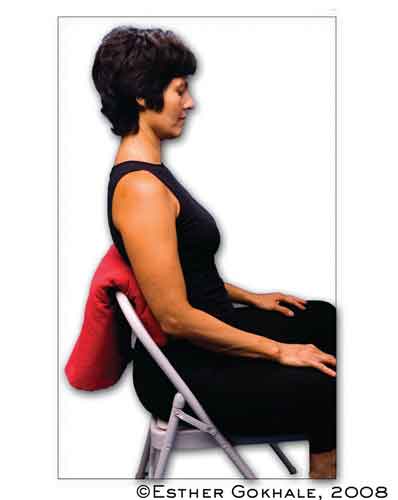
Y lo encontró tras visitar Sudamérica, Asia y África. En los tres continentes descubrió tribus que no conocían lo que era el dolor de espalda. En esos lugares remotos, Gokhale fotografió a mujeres cargando gran cantidad de peso o que se tiraban horas sentadas en el suelo. Analizando las imágenes, encontró que el secreto podía estar en la columna vertebral.
Columna en forma de 'J'
“La columna de los norteamericanos suele tener forma de ’S’”, explica Gokhale en una entrevista concedida a la radio NPR, “cuando están de pie se forma una curva en la parte de arriba, otra en la parte media y otra en la final. En las personas que jamás han tenido dolor de espalda no se ve esa forma, sino una ‘J’”.
 Columna en forma de 'S' (Izquierda) y columna en forma de 'J' (derecha)
Columna en forma de 'S' (Izquierda) y columna en forma de 'J' (derecha)Después de este hallazgo, Gokhale se ha dedicado a estudiar la figura humana en el arte, y ha descubierto que en las estatuas del Renacimiento o en los dibujos de Leonardo Da Vinci no se ve la espalda en ’S’, sino la ‘J’. Ella atribuye este cambio a que nos hemos olvidado de caminar y cargar con peso.
¿Pero cómo podemos recuperar esa forma saludable? Gokhale ha escrito varios libros sobre el tema, explicando ejercicios y posturas más saludables para sentarse o cargar con peso. Sus publicaciones han tendio tanto éxito que empresas como Google o Facebook le han pedido consejo para que sus trabajadores no padezcan dolores posturales.
La clave para acabar con el dolor de espalda
Pero no hace falta ver ningún libro de Gokhale para poder salvar nuestra dolorida parte de atrás. El doctor Praveen Mummaneni, un neurocirujano del centro especializado en columna vertebral de la Universidad de California en San Francisco (Estados Unidos) da validez a los hallazgos de Gokhale, ya que reconoce la forma de ’S’ y la forma de ‘J’, pero da un diagnóstico completamente diferente.
“En la actualidad, los occidentales pesan mucho más que los miembros de las tribus de África o la India. Y también pesan más que sus antepasados. Eso podría explicar el cambio de forma de la espalda: ahora la columna tiene que soportar más peso”, razona Mummaneni. “Incluso los occidentales que son más delgados tienen una ’S’ mucho menos pronunciada que los que tienen sobrepeso”.
Para el médico, la solución pasa por “perder peso y fortalecer los músculos de la espalda, los de las piernas y sobre todo, los abdominales. Así se repartirá mejor el peso y el dolor desaparecerá”.
Pero no hace falta ver ningún libro de Gokhale para poder salvar nuestra dolorida parte de atrás. El doctor Praveen Mummaneni, un neurocirujano del centro especializado en columna vertebral de la Universidad de California en San Francisco (Estados Unidos) da validez a los hallazgos de Gokhale, ya que reconoce la forma de ’S’ y la forma de ‘J’, pero da un diagnóstico completamente diferente.
“En la actualidad, los occidentales pesan mucho más que los miembros de las tribus de África o la India. Y también pesan más que sus antepasados. Eso podría explicar el cambio de forma de la espalda: ahora la columna tiene que soportar más peso”, razona Mummaneni. “Incluso los occidentales que son más delgados tienen una ’S’ mucho menos pronunciada que los que tienen sobrepeso”.
Para el médico, la solución pasa por “perder peso y fortalecer los músculos de la espalda, los de las piernas y sobre todo, los abdominales. Así se repartirá mejor el peso y el dolor desaparecerá”.
---------------------

Back pain is a tricky beast. Most Americans will at some point have a problem with their backs. And for an unlucky third, treatments won't work, and the problem will become chronic.
Believe it or not, there are a
few cultures in the world where back pain hardly exists. One indigenous
tribe in central India reported essentially none. And the discs in their
backs showed little signs of degeneration as people aged.
An acupuncturist in
Palo Alto, Calif., thinks she has figured out why. She has traveled
around the world studying cultures with low rates of back pain — how
they stand, sit and walk. Now she's sharing their secrets with back pain
sufferers across the U.S.
About two decades ago, Esther Gokhale
started to struggle with her own back after she had her first child. "I
had excruciating pain. I couldn't sleep at night," she says. "I was
walking around the block every two hours. I was just crippled."
Gokhale had a herniated disc.
Eventually she had surgery to fix it. But a year later, it happened
again. "They wanted to do another back surgery. You don't want to make a
habit out of back surgery," she says.

This
time around, Gokhale wanted to find a permanent fix for her back. And
she wasn't convinced Western medicine could do that. So Gokhale started
to think outside the box. She had an idea: "Go to populations where they
don't have these huge problems and see what they're doing."
Over the next decade, Gokhale
went to cultures around the world that live far away from modern life.
She went to the mountains in Ecuador, tiny fishing towns in Portugal and
remote villages of West Africa.
"I went to villages where every
kid under age 4 was crying because they were frightened to see somebody
with white skin — they'd never seen a white person before," she says.
Gokhale took photos and videos
of people who walked with water buckets on their heads, collected
firewood or sat on the ground weaving, for hours.
"I have a picture in my book of
these two women who spend seven to nine hours everyday, bent over,
gathering water chestnuts," Gokhale says. "They're quite old. But the
truth is they don't have a back pain."

She
tried to figure out what all these different people had in common. The
first thing that popped out was the shape of their spines. "They have
this regal posture, and it's very compelling."
And it's quite different than American spines.
If you look at an American's
spine from the side, or profile, it's shaped like the letter S. It
curves at the top and then back again at the bottom.
But Gokhale didn't see those
two big curves in people who don't have back pain. "That S shape is
actually not natural," she says. "It's a J-shaped spine that you want."
In fact, if you look at drawings from Leonardo da Vinci — or a Gray's Anatomy
book from 1901 — the spine isn't shaped like a sharp, curvy S. It's
much flatter, all the way down the back. Then at the bottom, it curves
to stick the buttocks out. So the spine looks more like the letter J.
"The J-shaped spine is what you see in Greek statues. It's what you see in young children. It's good design," Gokhale says.
So Gokhale worked to get her spine into the J shape. And gradually her back pain went away.
Then Gokhale realized she could help others. She developed a set of exercises, wrote a book and set up a studio in downtown Palo Alto.
Now her list of clients is impressive. She's helped YouTube CEO Susan Wojcicki and Matt Drudge of the Drudge Report.
She has given classes at Google, Facebook and companies across the
country. In Silicon Valley, she's known as the "posture guru."
Each year, doctors in the Bay Area refer hundreds of patients to Gokhale. One of them is Dr. Neeta Jain,
an internist at the Palo Alto Medical Foundation. She puts Gokhale's
method in the same category as Pilates and yoga for back pain. And it
doesn't bother her that the method hasn't been tested in a clinical
trial.
"If people are finding things
that are helpful, and it's not causing any harm, then why do we have to
wait for a trial?" Jain asked.
But there's still a big
question looming here: Is Gokhale right? Have people in Western cultures
somehow forgotten the right way to stand?
Scientists don't know yet, says Dr. Praveen Mummaneni,
a neurosurgeon at the University of California, San Francisco's Spine
Center. Nobody has done a study on traditional cultures to see why some
have lower rates of back pain, he says. Nobody has even documented the
shape of their spines.
"I'd like to go and take X-rays
of indigenous populations and compare it to people in the Western
world," Mummaneni says. "I think that would be helpful."
But there's a whole bunch of
reasons why Americans' postures — and the shape of their spines — may be
different than those of indigenous populations, he says. For starters,
Americans tend to be much heavier.
"If you have a lot of fat built
up in the belly, that could pull your weight forward," Mummaneni says.
"That could curve the spine. And people who are thinner probably have
less curvature" — and thus a spine shaped more like J than than an S.
Americans are also much less
active than people in traditional cultures, Mummaneni says. "I think the
sedentary lifestyle promotes a lack of muscle tone and a lack of
postural stability because the muscles get weak."
Everyone knows that weak
abdominal muscles can cause back pain. In fact, Mummaneni says, stronger
muscles might be the secret to Gokhale's success.
In other words, it's not that
the J-shaped spine is the ideal one — or the healthiest. It's what goes
into making the J-shaped spine that matters: "You have to use muscle
strength to get your spine to look like a J shape," he says.
So Gokhale has somehow figured
out a way to teach people to build up their core muscles without them
even knowing it. "Yes, I think that's correct," Mummaneni says. "You're
not going to be able to go from the S- to the J-shaped spine without
having good core muscle strength. And I think that's key here."
So indigenous people around the
world don't have a magic bullet for stopping back pain. They've just
got beefy abdominal muscles, and their lifestyle helps to keep them that
way, even as they age.
Copyright NPR. View this article on npr.org.
Transcript
ARI SHAPIRO, HOST:
Today
in Your Health - back pain. Most Americans have a problem with it at
some point. For a third of people in this country, treatments won't
work. The problem becomes chronic. There are a few places on Earth where
back pain hardly exists. These tend to be cultures that are far removed
from modern life. One woman at the epicenter of modern life in Palo
Alto, Calif., thinks she has figured out why these traditional societies
have such healthy backs. NPR's Michaeleen Doucleff reports.
MICHAELEEN DOUCLEFF, BYLINE: After she had her first baby, Esther Gokhale couldn't even bend down to pick up her child.
ESTHER
GOKHALE: I had excruciating pain. I could not sleep at night. I was
walking around the block every two hours. And I was just crippled.
DOUCLEFF: Gokhale had a herniated disc. Eventually she had surgery to fix it. But a year later, it happened again.
GOKHALE: And they wanted to do another surgery. And, you know, you don't want to make a habit out of back surgery.
DOUCLEFF:
Gokhale is a smart woman. She has a degree in biochemistry from
Harvard, and she's a licensed acupuncturist. This time around, she
wanted to think outside the box, and here's what she came up with.
GOKHALE: Go to populations where they don't have these huge problems and see what they're doing.
DOUCLEFF:
Gokhale went online and searched through medical studies, and she found
something intriguing - several studies of traditional populations
reporting very low rates of back pain. We're talking about people who
live far away from modern life. Now, most of us would've stopped there -
at doing research on the web - but not Gokhale. She went to the
mountains in Ecuador, to tiny fishing towns in Portugal and to the
remote deserts of West Africa.
GOKHALE:
Like, I went to villages where every kid under 4 was, you know, like,
crying, frightened to see someone with white skin. They'd never seen a
white person before.
DOUCLEFF:
Gokhale took photos of people who walked with water buckets on their
heads, collected firewood or sat on the ground weaving for hours.
GOKHALE:
I have a picture in my book of these two women who spend seven to nine
hours every day, bent over, gathering water chestnuts. And they're not
spring chickens; they're quite old. But the truth is that they don't
have back problems.
DOUCLEFF:
She tried to figure out what all these different people had in common,
and the first thing that popped out was the shape of their spines.
GOKHALE: They have this regal posture, and it's a very compelling.
DOUCLEFF:
And quite different than American spines. Here's an experiment. Take a
friend and have them stand up and turn to their left so you're looking
at them in profile. If they have what we think of as good posture, then
their spine is shaped like an S. It curves at the top and then back
again at the bottom. This is what's drawn in medical books. But Gokhale
didn't see those two big curves in people who don't have back pain.
GOKHALE: That S-shaped spine is actually not natural. It's a J-shaped spine that you want.
DOUCLEFF:
In fact, if you look at drawings from da Vinci - or a "Gray's Anatomy"
book from 1901 - the spine isn't shaped like a curvy S. It's much
flatter almost all the way down the back. And then at the bottom, it
curves to stick the butt out, so it looks more like a J. It seemed to
her that this J shape was key to a pain-free back, so she developed a
set of exercises to get her spine into the J shape. And gradually, her
back pain went away. Then Gokhale realized she could help others. She
wrote a book, set up a studio in downtown Palo Alto.
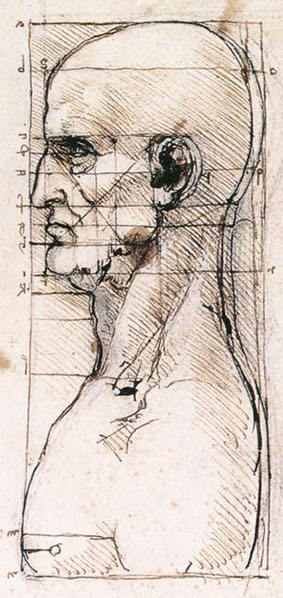
UNIDENTIFIED WOMAN: And so without further ado, welcome Esther from all of us here in Silicon Valley.
DOUCLEFF:
The day I caught up with her, she was giving a workshop at one of the
biggest law firms in the world - Jones Day in Palo Alto. About 50
workers dressed in khakis and pencil skirts came to learn how they could
sit at their computers for hours without hurting their backs. Gokhale
brings a volunteer to the front to demonstrate the most common problem -
the way we hold our shoulders.
GOKHALE:
Now, if we look at you from the front view, we can see that the portion
of her hand that faces forward is mostly her knuckles and not so much
the thumb.
DOUCLEFF:
Americans tend to scrunch their shoulders forward so our arms are
turned in. That's not how people in indigenous cultures carry their
arms.
GOKHALE: And we're going to show you a very simple way of addressing this.
DOUCLEFF:
Gokhale gently takes the woman's shoulders, pulls them up, pushes them
back and lets them drop, like a shoulder roll. And then the woman's arms
dangle by her side.
GOKHALE:
This is the way all your ancestors parked their shoulders. This is a
natural architecture for our species. So it behooves us all to explore
this.
DOUCLEFF:
Her list of clients is impressive. She's helped YouTube CEO Susan
Wojcicki, Matt Drudge of the Drudge Report, and she's given classes at
Google, Facebook.
In Silicon Valley, she's known as the posture guru. Doctors in the Valley refer hundreds of patients to her, and they put her method in the same category as Pilates and yoga for back pain. But there's still a big question - is she right? Have people in Western society somehow forgotten the right way to stand? Praveen Mummaneni knows spines intimately. He operates on them three times a week and co-directs the Spine Center at the University of California in San Francisco. Mummaneni says scientists don't know yet why some traditional cultures have fewer problems with back pain. Nobody's done a systematic study or even documented the shape of their spines.
In Silicon Valley, she's known as the posture guru. Doctors in the Valley refer hundreds of patients to her, and they put her method in the same category as Pilates and yoga for back pain. But there's still a big question - is she right? Have people in Western society somehow forgotten the right way to stand? Praveen Mummaneni knows spines intimately. He operates on them three times a week and co-directs the Spine Center at the University of California in San Francisco. Mummaneni says scientists don't know yet why some traditional cultures have fewer problems with back pain. Nobody's done a systematic study or even documented the shape of their spines.
PRAVEEN
MUMMANENI: I'd like to go and take X-rays of indigenous populations and
compare it to the Western world. I think that would be very helpful.
DOUCLEFF:
But Mummaneni says there's a whole bunch of reasons why postures of
Americans and the shape of their spines may be different than indigenous
populations. For starters, Americans tend to be much heavier.
MUMMANENI: If you have a lot of fat built up in your belly, it can tend to pull your low back forward.
DOUCLEFF: And that would curve the spine?
MUMMANENI: That could curve the spine. And people who are fairly thin probably have less curvature.
DOUCLEFF:
And, thus, a spine shaped more like a J than an S. Mummaneni also
points out that Americans are much less active than people in
traditional cultures.
Do you think that that sedentary lifestyle could have an effect on the spine shape?
MUMMANENI:
I think the sedentary lifestyle promotes a lack of muscle tone and a
lack of postural stability because the muscles get weak.
DOUCLEFF:
Everyone knows that weak abdominal muscles can cause back pain. And, in
fact, Mummaneni says that might be the secret to Gokhale's success.
It's not that the J shape is the ideal one or the healthiest. It's what
goes into making the J shape that matters.
MUMMANENI: And you have to use muscle strength to get it to look like the J-shaped spine.
DOUCLEFF: So Gokhale has somehow figured out a way to teach people to build up their core muscles without them even knowing it.
MUMMANENI:
Yes, I think that's correct. You're not going to be able to go from the
S to the J without having good core muscle strength, and I think that's
a key here.
DOUCLEFF:
In other words, indigenous people around the world don't have a magic
bullet for stopping back pain. They've just got beefy abdominal muscles,
and their lifestyle helps to keep them that way even as they age.
Michaeleen Doucleff, NPR News.
SHAPIRO:
At NPR's "Goats and Soda" blog, you can find Esther Gokhale's five tips
for better posture and less back pain. Transcript provided by NPR,
Copyright NPR.
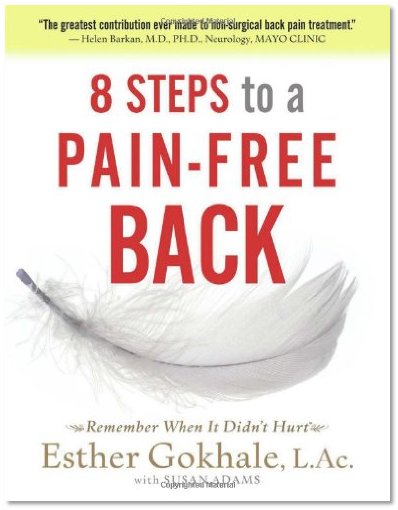 Summary: In this post I explain how to have the right sitting posture for maximizing long-term productivity and health (hint: it's not the advice you've always been given)
Summary: In this post I explain how to have the right sitting posture for maximizing long-term productivity and health (hint: it's not the advice you've always been given)
In workflow design, we care about the holistic experience of our work. How we care for and use our bodies is, for that reason, one of the most fundamental drivers of productivity.
Now you probably think I'm going to tell you to "have good posture" like everyone from your parents to your doctors has told you since you were a child.
But have you ever wondered what exactly "good posture" means?
After years of experimenting with every trendy solution short of surgery (fancy office chairs, standing desks, ball chairs, massage, yoga, ergonomics) to fix the discomfort I felt sitting for long periods of time, I've discovered a new posture technique that I believe treats the core problem instead of the symptoms: the Gokhale Method (pronounced Go-clay).
Esther Gokhale is known as "The Posture Guru of Silicon Valley," and her book 8 Steps to a Pain-Free Back has shot to the #1 spot in the category on Amazon, despite basically contradicting everything we've ever been told about posture ( I have no financial or other interest in her business).
The Gokhale Method is simple, easy, requiring minimal time investment, and no special equipment. Its aim is to teach you to sit, stand, and move like our ancestors did, before modern furniture and the fashion industry conspired to mold us into more "modern" positions.
She points to research in traditional societies and indigenous cultures showing that back pain is almost unknown, even among manual laborers and long-term sitters.
In this post I will summarize the first, and most important, technique of the Gokhale Method: stretchsitting.
If you are skeptical, which you should be, spend 20 minutes learning this technique and try it for a week, and you will become a believer.
Here is the video version of this lesson as well: End Back Pain: Stretchsitting
----------------------------------------------------------------------------------------------------------------------------------------
Summary of Technique #1: Stretchsitting
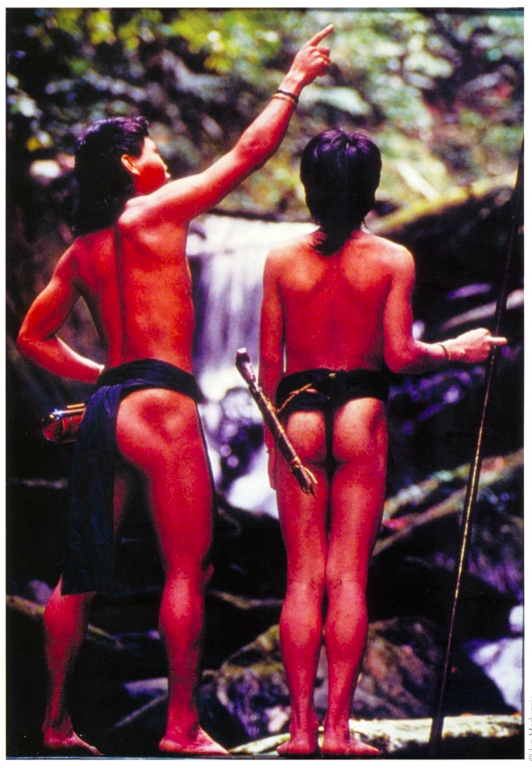
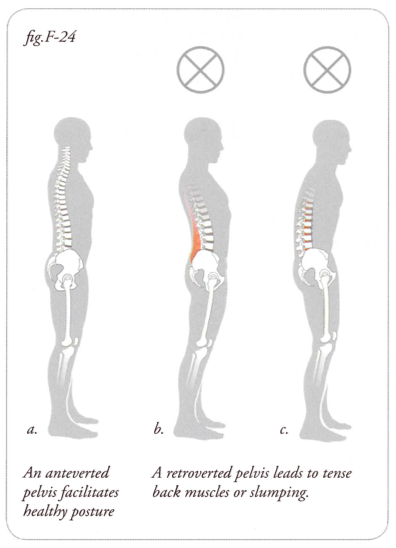
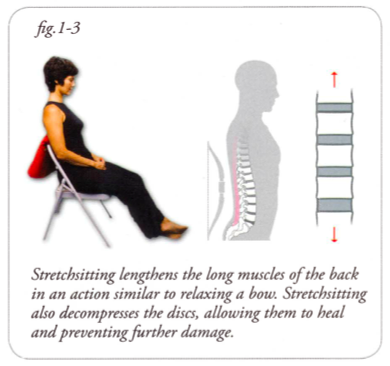
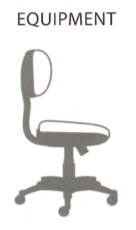
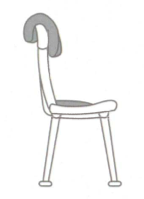
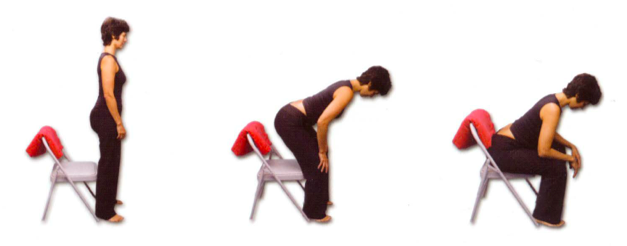
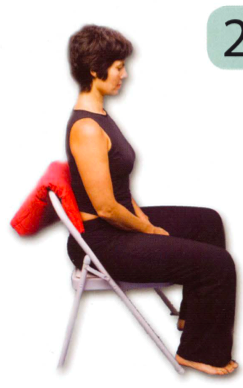
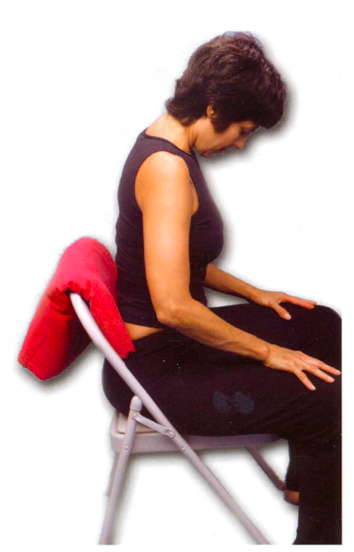
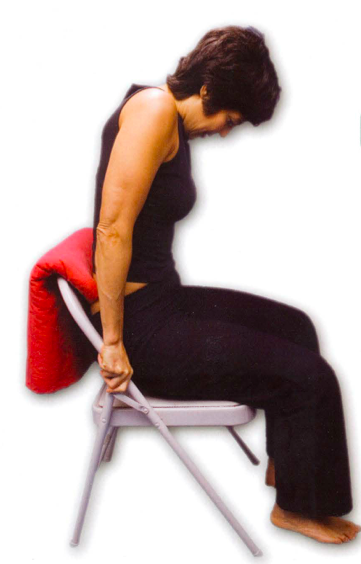
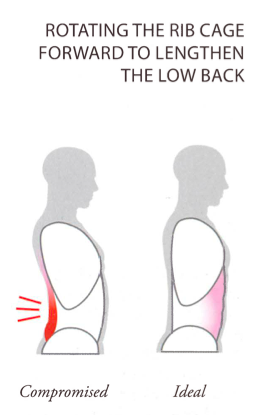
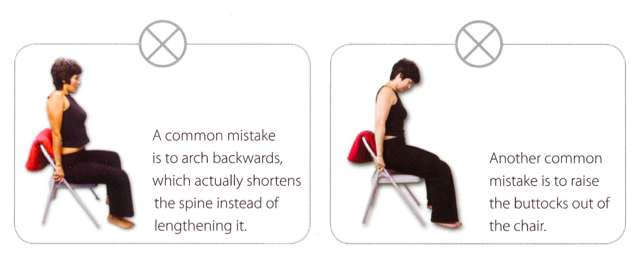
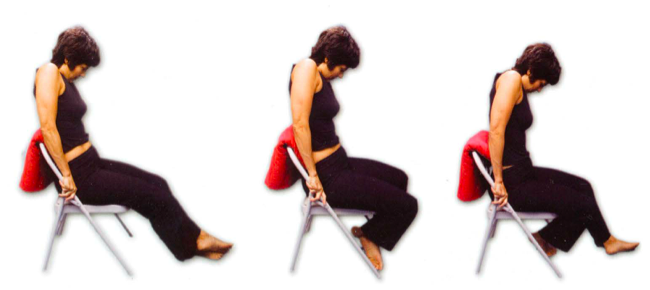
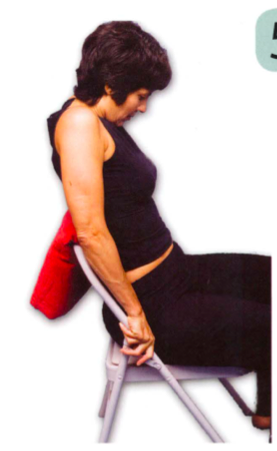

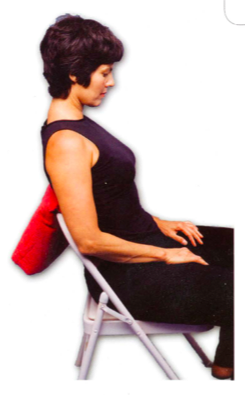
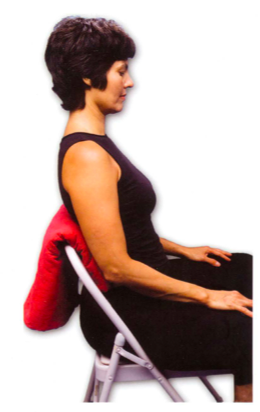
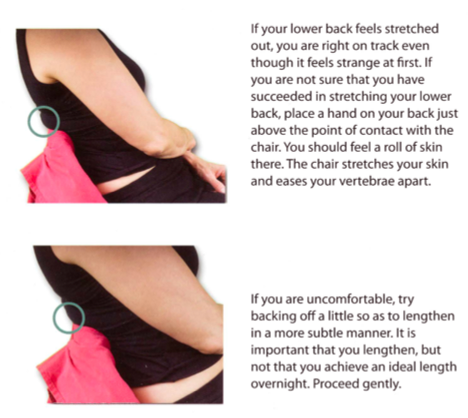
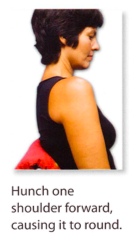
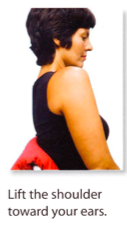
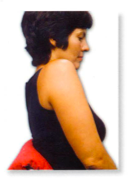
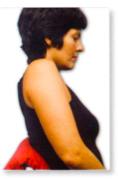
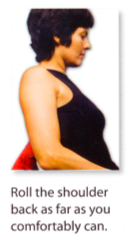
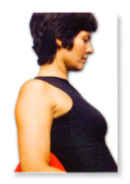
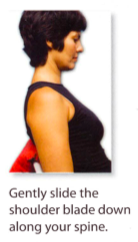

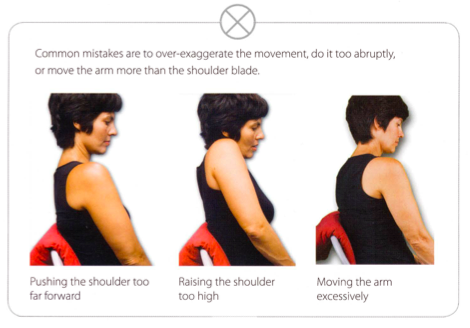
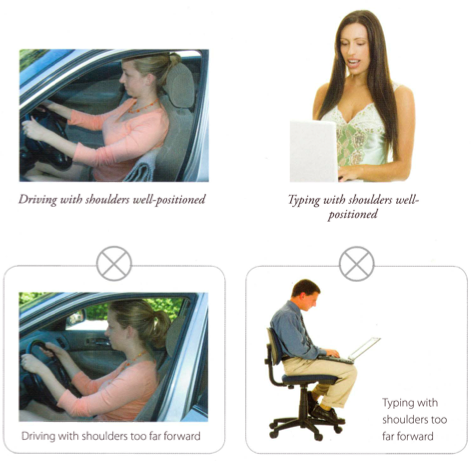
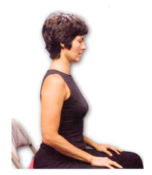
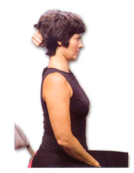
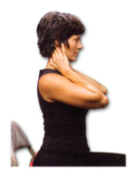
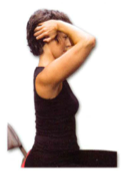
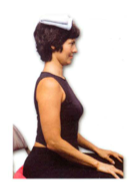
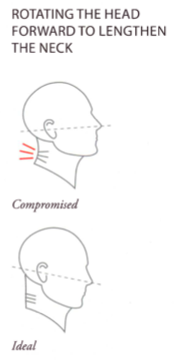
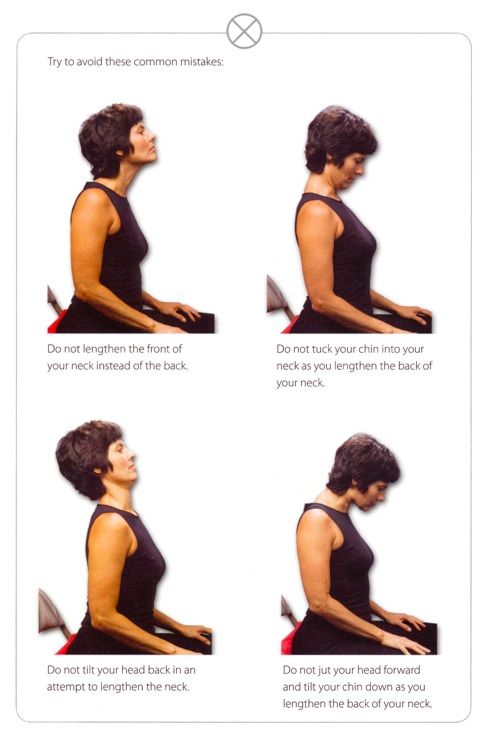
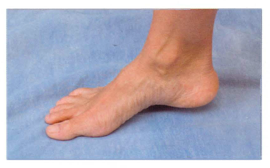
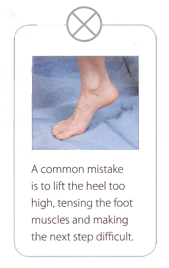
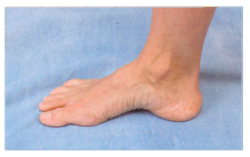
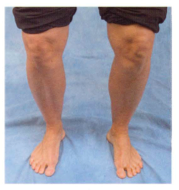
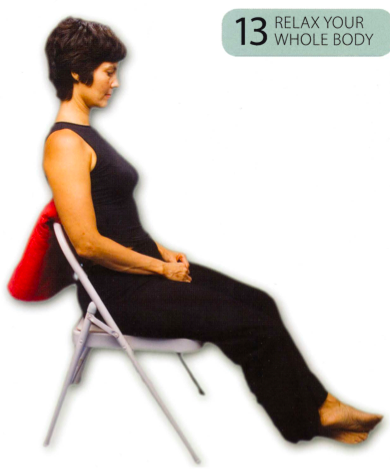
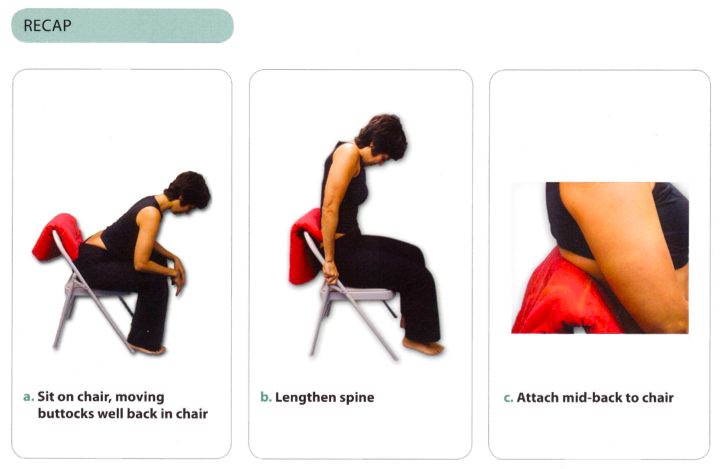
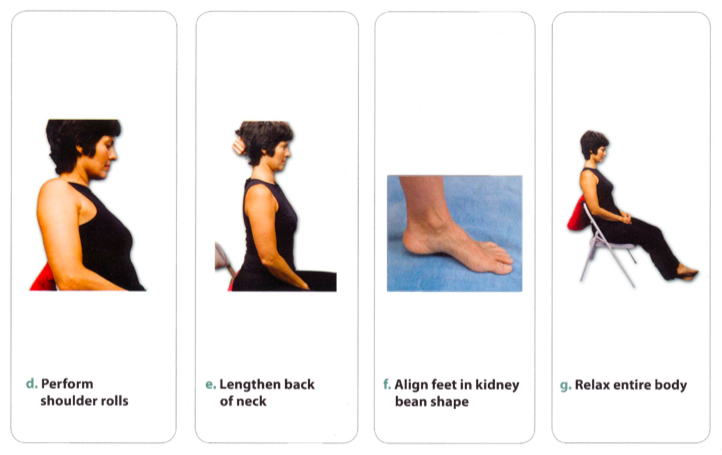
How to adopt the right sitting posture for productivity
October 25, 2013 Summary: In this post I explain how to have the right sitting posture for maximizing long-term productivity and health (hint: it's not the advice you've always been given)
Summary: In this post I explain how to have the right sitting posture for maximizing long-term productivity and health (hint: it's not the advice you've always been given)In workflow design, we care about the holistic experience of our work. How we care for and use our bodies is, for that reason, one of the most fundamental drivers of productivity.
Now you probably think I'm going to tell you to "have good posture" like everyone from your parents to your doctors has told you since you were a child.
But have you ever wondered what exactly "good posture" means?
After years of experimenting with every trendy solution short of surgery (fancy office chairs, standing desks, ball chairs, massage, yoga, ergonomics) to fix the discomfort I felt sitting for long periods of time, I've discovered a new posture technique that I believe treats the core problem instead of the symptoms: the Gokhale Method (pronounced Go-clay).
Esther Gokhale is known as "The Posture Guru of Silicon Valley," and her book 8 Steps to a Pain-Free Back has shot to the #1 spot in the category on Amazon, despite basically contradicting everything we've ever been told about posture ( I have no financial or other interest in her business).
The Gokhale Method is simple, easy, requiring minimal time investment, and no special equipment. Its aim is to teach you to sit, stand, and move like our ancestors did, before modern furniture and the fashion industry conspired to mold us into more "modern" positions.
She points to research in traditional societies and indigenous cultures showing that back pain is almost unknown, even among manual laborers and long-term sitters.
In this post I will summarize the first, and most important, technique of the Gokhale Method: stretchsitting.
If you are skeptical, which you should be, spend 20 minutes learning this technique and try it for a week, and you will become a believer.
Here is the video version of this lesson as well: End Back Pain: Stretchsitting
----------------------------------------------------------------------------------------------------------------------------------------
Summary of Technique #1: Stretchsitting
Defining good posture
First, we need to define what good posture actually looks like.

Look at this picture of Ubong tribesman as you read this description of good posture:
- The pelvis is tipped forward (or anteverted). An easy way to see this is to imagine a belt line and notice that it angles downward toward the front.
- There is an even groove along the vertical midline of the back. The groove is not especially deep in any place (for example, the low back), nor are the vertebrae prominent in any location (for example, the upper back).
- The shoulders are positioned behind the torso, so that the arms align with the back of the torso. The arms are externally rotated so that the thumbs face forward.
- The front contour of the torso is dome-like and smooth. The lower border of the rib cage does not protrude from, but rather is flush with, the abdominal contour. The chest is full with a raised sternum as a result of the chest expanding with every breath.
- There is a soft angle at the groin between the front of the torso and the legs that lets the femoral arteries, veins, and nerves function normally.
- The chin, and an imaginary line joining the middle of the ear and the tip of the nose, angle downward as a result of a relaxed and elongated cervical spine.
- The buttock muscles are well developed because they are positioned correctly.
- The muscles throughout the body have good tone (not bunched up with long taut tendons attached to bone).
- The main weight-bearing bones in the body are vertically aligned over the heels.
- The feet point 10-15 degrees outwards and the arches of the foot are muscular and pronounced.
Key Principles
So how can we create this posture? There are 6 key underlying principles at work:
1. Anteverted pelvis
This
is the foundation for everything else, but is the opposite of what most
people think of as "good posture." Parents and doctors will tell you to
have a "neutral" pelvic position that is slightly or very "tucked."
This retroverted pelvic position leads you into one of two common, yet damaging postures:
- you sit upright, but your low back muscles are tense, or
- you relax, but your upper body slumps forward
The
ideal position is to have the top of your pelvis tilting forward
(anteversion). This allows your vertebrae to be naturally stacked
without muscle strain, and aligns your weight over your strongest bones
(which, by the way, need a certain level of stress to remain healthy).

Look at this picture of Ubong tribesman as you read this description of good posture:
- The pelvis is tipped forward (or anteverted). An easy way to see this is to imagine a belt line and notice that it angles downward toward the front.
- There is an even groove along the vertical midline of the back. The groove is not especially deep in any place (for example, the low back), nor are the vertebrae prominent in any location (for example, the upper back).
- The shoulders are positioned behind the torso, so that the arms align with the back of the torso. The arms are externally rotated so that the thumbs face forward.
- The front contour of the torso is dome-like and smooth. The lower border of the rib cage does not protrude from, but rather is flush with, the abdominal contour. The chest is full with a raised sternum as a result of the chest expanding with every breath.
- There is a soft angle at the groin between the front of the torso and the legs that lets the femoral arteries, veins, and nerves function normally.
- The chin, and an imaginary line joining the middle of the ear and the tip of the nose, angle downward as a result of a relaxed and elongated cervical spine.
- The buttock muscles are well developed because they are positioned correctly.
- The muscles throughout the body have good tone (not bunched up with long taut tendons attached to bone).
- The main weight-bearing bones in the body are vertically aligned over the heels.
- The feet point 10-15 degrees outwards and the arches of the foot are muscular and pronounced.
Key Principles
So how can we create this posture? There are 6 key underlying principles at work:
1. Anteverted pelvis
This
is the foundation for everything else, but is the opposite of what most
people think of as "good posture." Parents and doctors will tell you to
have a "neutral" pelvic position that is slightly or very "tucked."
This retroverted pelvic position leads you into one of two common, yet damaging postures:
- you sit upright, but your low back muscles are tense, or
- you relax, but your upper body slumps forward
The
ideal position is to have the top of your pelvis tilting forward
(anteversion). This allows your vertebrae to be naturally stacked
without muscle strain, and aligns your weight over your strongest bones
(which, by the way, need a certain level of stress to remain healthy).
2. A gently curved, elongated spine
The ideal shape of the spine is a gentle, elongated curve, not an exaggerated “S” curve.
We're
always told "chin up and chest out," which creates a spine that curves
forward in the low back, backward in the upper back, and forward again
in the neck. Most modern furniture and clothing reflects and reinforces
this exaggerated curve.
3. Every bone in its natural place
The
human skeleton is the product of millions of years of fine-tuned
evolution. Each bone has a natural place relative to its neighbors.
Adjacent bones are designed to fit together in a certain way.
Our
weight-bearing bones need stress to remain strong, but when they're
misaligned, even moderate stress results in damage and pain.
4. Using muscles more than joints
Most
people use their joints too much, and their muscles not enough. Muscles
get weak from underuse, and joints get damaged. Not good.
This method teaches you how to walk and bend correctly, using your muscles to take the burden off your joints.
5. Muscles fully relaxed when not working
When
something is wrong with our musculo-skeletal system, we're often
directed to some sort of physical strengthening exercise, like in
physical therapy. But actually muscle relaxation is just as important as
strength.
For muscles to be healthy, they need to
relax. Misalignment often becomes habit and people get locked into
positions that wear their muscles unnecessarily.
6. Breathing as a therapeutic exercise
Besides,
you know, keeping you alive, breathing has another purpose: to exercise
the key tissues of the chest and spinal area, keeping them
well-circulated and healthy.
The natural elastic movement of breathing provides a massage-like action that promotes circulation. How cool is that?
When you stack your vertebrae correctly, the muscles around your spine will relax, facilitating this elastic action.
Summary of Technique #1: Stretchsitting
The
goal of stretchsitting is to lengthen your spine against the back of a
chair. This decompresses your discs (preventing damage) and stretches
your back muscles (helping them adjust to longer baseline lengths).

Equipment
You will need a basic chair, such as a secretarial chair or padded folding chair. It should have:- a firm seat
- a low, straight backrest that, if adjustable, can be locked into position
- an outcropping at the mid-back level to which you can "hitch" your spine.


Look at this picture of Ubong tribesman as you read this description of good posture:
The pelvis is tipped forward (or anteverted). An easy way to see this is to imagine a belt line and notice that it angles downward toward the front.
There is an even groove along the vertical midline of the back. The groove is not especially deep in any place (for example, the low back), nor are the vertebrae prominent in any location (for example, the upper back).
The shoulders are positioned behind the torso, so that the arms align with the back of the torso. The arms are externally rotated so that the thumbs face forward.
The front contour of the torso is dome-like and smooth. The lower border of the rib cage does not protrude from, but rather is flush with, the abdominal contour. The chest is full with a raised sternum as a result of the chest expanding with every breath.
There is a soft angle at the groin between the front of the torso and the legs that lets the femoral arteries, veins, and nerves function normally.
The chin, and an imaginary line joining the middle of the ear and the tip of the nose, angle downward as a result of a relaxed and elongated cervical spine.
The buttock muscles are well developed because they are positioned correctly.
The muscles throughout the body have good tone (not bunched up with long taut tendons attached to bone).
The main weight-bearing bones in the body are vertically aligned over the heels.
The feet point 10-15 degrees outwards and the arches of the foot are muscular and pronounced.
The pelvis is tipped forward (or anteverted). An easy way to see this is to imagine a belt line and notice that it angles downward toward the front.
There is an even groove along the vertical midline of the back. The groove is not especially deep in any place (for example, the low back), nor are the vertebrae prominent in any location (for example, the upper back).
The shoulders are positioned behind the torso, so that the arms align with the back of the torso. The arms are externally rotated so that the thumbs face forward.
The front contour of the torso is dome-like and smooth. The lower border of the rib cage does not protrude from, but rather is flush with, the abdominal contour. The chest is full with a raised sternum as a result of the chest expanding with every breath.
There is a soft angle at the groin between the front of the torso and the legs that lets the femoral arteries, veins, and nerves function normally.
The chin, and an imaginary line joining the middle of the ear and the tip of the nose, angle downward as a result of a relaxed and elongated cervical spine.
The buttock muscles are well developed because they are positioned correctly.
The muscles throughout the body have good tone (not bunched up with long taut tendons attached to bone).
The main weight-bearing bones in the body are vertically aligned over the heels.
The feet point 10-15 degrees outwards and the arches of the foot are muscular and pronounced.
Key Principles
So how can we create this posture? There are 6 key underlying principles at work:
1. Anteverted pelvis
This
is the foundation for everything else, but is the opposite of what most
people think of as "good posture." Parents and doctors will tell you to
have a "neutral" pelvic position that is slightly or very "tucked."
This retroverted pelvic position leads you into one of two common, yet damaging postures:
- you sit upright, but your low back muscles are tense, or
- you relax, but your upper body slumps forward
The
ideal position is to have the top of your pelvis tilting forward
(anteversion). This allows your vertebrae to be naturally stacked
without muscle strain, and aligns your weight over your strongest bones
(which, by the way, need a certain level of stress to remain healthy).
If
your chair lacks an outcropping, you can make one from a folded towel
or flannel sheet placed just below the shoulder blades. This
outcropping:
- Offers a place to hitch your mid-back (discussed later)
- Gives your buttocks space to settle behind you in the chair
- Provides enough clearance to let you perform a shoulder roll (discussed later)
Steps
Step 1: Sit down, placing your buttocks well back in the chair

If
the chair has a gap between the seat and the back, be careful not to
place your buttocks too far back. If you do, your back will sway in
later steps.
Step 2: Place your feet about hip-width apart and relax your legs

Step 3: Lengthen your spine

Bend
at the waist and curve forward slightly to lengthen your low back. This
eliminates any sway you may have, and prevents your introducing one in
the next step.
Step 4: Further lengthen your spine

Leave
your buttocks anchored to the chair. With both hands, hold on to some
part of the chair (armrests, backrest, or seat) and push with your arms.
Relax the muscles of your torso, allowing the rib cage to separate as
much as possible from the pelvis.

Don't do this:

Be
sure you are not engaging your leg muscles in this step. If you find
they are tense, stretch your legs forward, fold them under your chair,
or use any relaxed position.

Step 5: Attach your mid-back to the backrest or cushion

Keeping
your arms engaged to maintain the extra length in your spine, "hitch"
your back to the backrest of the chair. Think of pinning a point in your
mid-back as high as possible on the backrest. For most people, this
will be about an inch higher than normal.
It may help to imagine that you are hanging from the point of contact with the chair like a picture frame hangs from a wall.

Step 6: Release the tension in your arms
Feel the chair take the weight as you release your arms.

Step 7: Straighten your upper back

Now
your lower back is in traction. Be sure not to arch back over the chair
nor to press so hard against the backrest as to cause discomfort.

Step 8: Perform a shoulder roll with each shoulder
As
with all these new movements, the shoulder roll may feel exaggerated
and awkward at first, something you wouldn't be comfortable doing in
public. With practice and time, the movement becomes subtle, and you can
easily incorporate it into seating yourself at a company meeting, in a
restaurant, or on your sofa.







When
doing a shoulder roll, imagine the shoulder's soft tissue ratcheting
back one notch on a cogged wheel. Unless the pectoral muscles are very
tight (lucky you), the shoulders tend to remain in this position without
any sustained muscular effort.

Don't do this:

After
performing a shoulder roll, you may notice that your reach is shorter.
This is because your arms now originate further back than before. This
is a healthy home base position that
you don't want to compromise during normal activities. The solution is
to adjust your distance from your task. For example, when working at a
computer, you may need to move the keyboard closer. When driving a car,
you may need to move your car seat closer to the steering wheel (but
keep a safe distance from the airbag).

Step 9: Lengthen the back of your neck
Though
you have lengthened your back, your neck may still be compressed. There
are many ways to lengthen the neck. If your neck is injury-prone,
choose Option A or a very gentle version of Option B. If you are looking
to make fast progress, use Option E occasionally. Otherwise, choose
according to what is comfortable for you. The goal is a neutral neck
position with the jaw gliding back and up and the chin angled down.
Option A. Imagine a helium balloon inside your head. Consciously release any tension in your neck muscles that works against the balloon's upward thrust.

Option B. Grab a clump of hair at the base of your skull and gently pull it back and up.

Option C.
Position your fingertips in the two side indentations at the base of
your skull (the occipital grooves) and move your skull up and away from
your body.

Option D. Grasp the base of your skull with both hands and gently pull upward while lowering your shoulders.

Option E. Place (or imagine) a light object on the crown of your head. Push up against it.



Step 10: While continuing to stretch sit, fix the toes and ball of one foot on the floor while lifting the heel
Lift foot just high enough so that the heel clears the floor.


Step 11: Twist and pivot the heel inward before planting it firmly on the floor.
Your goal is to create a "kidney- bean" shape with your foot.

Step 12: Repeat this action with the other foot
Notice that your knees point in the same direction as your toes.

Step 13: Relax your whole body
Let the chair do all the work. Try to locate any tension in your body and release it. Reposition your legs as you wish.
If
you find that you settle back to your habitual position after awhile,
you will need to reset your position periodically. Simply repeat the
steps of this lesson.



I sincerely hope you will at least give this posture method a try. Also check out the book for lots of other techniques and lessons. Report back with your results in the comments!
No hay comentarios:
Publicar un comentario